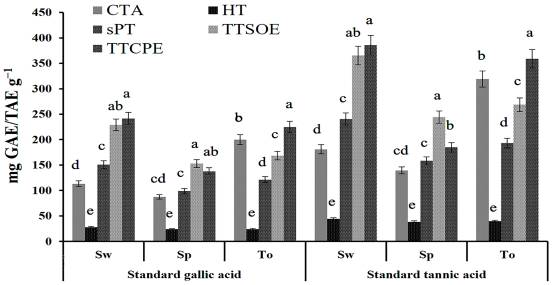Seaweed Tannin Qualitative and Quantitative Profiling Service
Tannin Analysis Helps Researchers to Evaluate Seaweed
Seaweed is a renewable biological resource that possesses a wide range of metabolites, including tannins. Creative Biolabs offers a one-stop seaweed tannin analysis service with reliable analytical methods. With our extensive expertise, proven analytical methods, and attention to detail, we provide accurate results and valuable insights for our clients' seaweed research.
Tannin analysis helps to study the biological activity, health benefits, and industrial applications of Biomasses such as Seaweeds. We have developed a complete analytical protocol for tannins in seaweeds that applies to all types of seaweeds and sample types. All samples are analyzed in duplicate to ensure the accuracy of the results.
-
Determination of total tannin content: We use optimized and validated methods to accurately quantify the total tannin content of seaweed samples for seaweed quality assessment and industrial application studies.
-
Tannin analysis and characterization: Seaweeds contain a wide variety of tannins. We use a variety of chromatographic techniques to analyze and characterize tannins in seaweeds by designing tailor-made analytical protocols to meet our client's specific research needs.
-
Gas chromatography-mass spectrometry (GC-MS): It is often used for the analysis of volatile tannins and their derivatives.
-
Liquid chromatography-mass spectrometry (LC-MS): It is a highly efficient and accurate analytical technique for the separation and detection of tannins in complex mixtures.
 Fig.1 Process for analyzing tannins in seaweed.
Fig.1 Process for analyzing tannins in seaweed.
Features of Seaweed Tannin Analysis Service
-
Efficient tannin analysis: We use optimized and validated analytical protocols for short cycle time and scientifically accurate results.
-
Strict quality control system: We have a strict quality control system to ensure the accuracy and precision of the tannin analysis results.
-
Detailed analytical reports: Our experienced team of experts provides comprehensive data analysis reports.
Creative Biolabs provides a convenient, efficient, and accurate total seaweed tannin analysis for various seaweed researchers and enterprises. In addition to tannins, we also offer Elements, Fatty Acids, and Phytohormones analysis services in seaweed. We put the satisfaction of client's needs as the priority and provide diversified choices for clients. Welcome to contact us for more information and a detailed quotation about seaweed tannin analysis, if you are interested in our service.
Published data
Tannins are phenolic substances with three forms that are present in a variety of plants including seaweeds. In this study, tannin content and bioactivity in three types of drifting brown seaweeds were examined. It was found that the extraction methods (cold osmosis, Soxhlet extraction, etc.) affect the detection of tannin content in seaweeds. By treating the extracted tannins to the cotton leafhopper, the researchers found that the tannins extracted from the three seaweeds exhibited insecticidal activity through three mechanisms. Therefore, these three seaweeds could be used to manage cotton leafhoppers safely. Through this study, we have learned some methods of extracting and analyzing the tannin content in seaweeds, which also helps us to analyze better and study the application value of seaweeds.
 Fig.2 Content of various types of tannins under different extraction methods.1, 2
Fig.2 Content of various types of tannins under different extraction methods.1, 2
FAQs
Q1: What factors affect the tannin content in seaweed?
A1: Seaweed species, tissue type, light intensity, season, nutritional level, ambient temperature, etc., will also affect the tannin content in seaweed. In addition, material handling and extraction methods (freeze-drying, sun-drying, etc.) can also affect the tannin content of seaweeds detected.
Q2: How to analyze tannins in seaweed?
A2: There are various analytical techniques to detect the tannin content in seaweeds, such as spectrophotometry and colorimetry. In addition, individual tannin compounds in seaweed samples are analyzed using LC-MS, GC-MS, and other techniques.
Customer Review
Rapid Analysis Cycle
"Although analyzing tannins was a routine operation to understand seaweed treatments, nutrient composition, and application value, it was a challenging task for us. We would like to find a partner that could comprehensively analyze seaweed tannins in large quantities. Through careful consideration, we chose to work with Creative Biolabs. Their efficient and reliable method for analyzing tannins in our samples helped us to carry out subsequent experiments as quickly as possible. We would be using them again for the seaweed tannin analysis service."
Flexible Solutions
"We needed to comparatively analyze the effect of different treatments on tannins in seaweeds. We were very satisfied with the seaweed tannin analysis service at Creative Biolabs. The team demonstrated a wealth of knowledge in this area. They promptly adjusted the seaweed tannin analysis protocol for our samples, paving the way for our subsequent studies."
References
-
Petchidurai, Ganeshan, et al. "Insecticidal Activity of Tannins from Selected Brown Macroalgae against the Cotton Leafhopper Amrasca devastans." Plants 12.18 (2023): 3188.
-
Under Open Access license CC BY 4.0, without modification.
For Research Use Only.
Related Services

 Fig.1 Process for analyzing tannins in seaweed.
Fig.1 Process for analyzing tannins in seaweed.
 Fig.2 Content of various types of tannins under different extraction methods.1, 2
Fig.2 Content of various types of tannins under different extraction methods.1, 2

